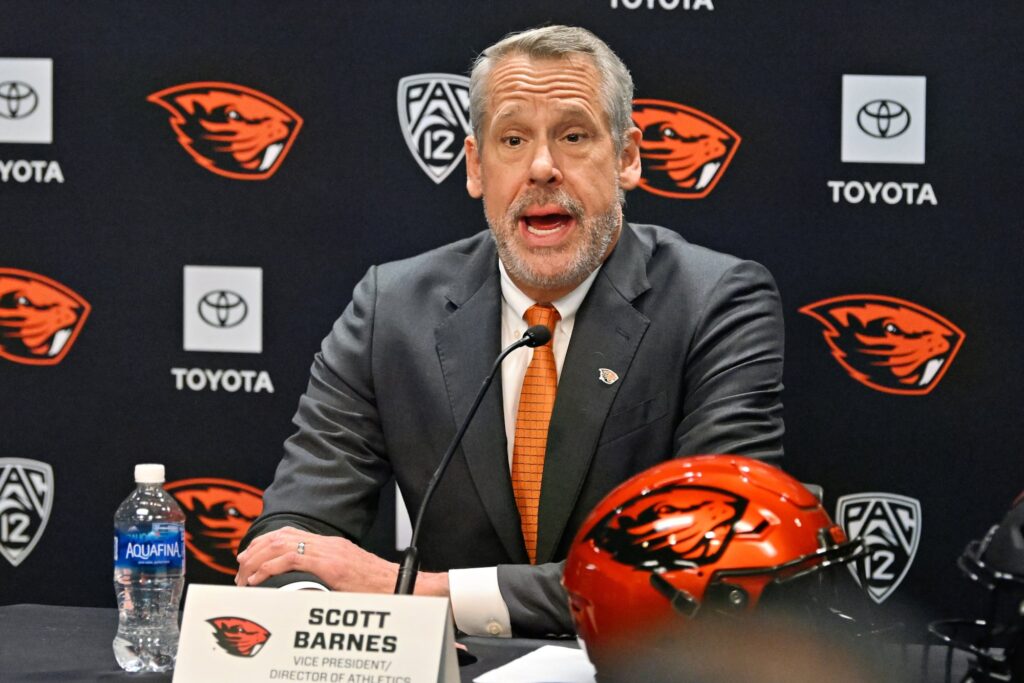A new general manager, varied and creative funding sources, and a focus on overachieving given the resources.
The revenue sharing era in college sports begins July 1, now that the long-awaited House settlement has been approved.
Oregon State
athletic director Scott Barnes said in a phone conversation this week that he is “excited” about what this means for the Beavers, who are in the process of restructuring their athletic department as the Pac-12 emerges from the ashes of conference realignment.
The framework laid out by the House settlement includes a $20.5 million salary cap per school, a tracking and reporting system for the NCAA to monitor NIL deals, an enforcement arm, and more to regulate student-athletes being paid.
At the federal level, momentum is build for legislation to codify these rules and eliminate a patchwork of state laws which critics say could give one school an advantage over the other depending on the state. The Pac-12 joined four other power conferences in throwing its weight behind the SCORE act in Congress, which among other things would prevent student-athletes from being classified as employees in the revenue sharing era.
The Oregonian/OregonLive spoke with Barnes — who also serves on the committee tasked with crafting and implementing rules based on the House settlement — for a Q&A discussing the path forward for OSU and for college sports:
In general, how will the House settlement immediately impact schools like Oregon State?
Specifically for OSU, like so many other schools, it has put pressure on our fundraising and revenue generation unit. The structure that we have in place, I’m excited about the progress there. We’re doing things like a student enrichment fee that has been well-received, the coach’s circle, athletic fund for excellence, and fearless — which provides new funding for student-athletes specifically in women’s sports. More pressure for sure on our systems, but with that comes new opportunities to provide for our student-athletes.
How much do you expect to have in revenue sharing money for the 2025-26 academic year?
Our intent is to be really competitive in our league, and those we’ve recruited against and will continue to recruit against. The actual number, we’re building the plane as it leaves the tarmac in terms of the dollars. But we’ll be competitive with those we’ve typically recruited against.
Will this new system allow schools like OSU to close the gap between yourselves and some of the biggest spenders?
Never has our university been in a position, nor will we ever be, nor do we need to be in a position to compete with the top of the Power Five in terms of budget and resources. We will find a way to compete on the field through competition, as we always do. We’ll punch above our weight, undaunted, and we don’t back down. But as it relates to resources, we’ve never had resources when people talk about the Texas, the Oklahoma, the Ohio States of the world in terms of payrolls. Frankly, it doesn’t impact us. It never has. Those aren’t the folks we are recruiting against. Yet we’ve proven we can compete at a regional and national level.
How will the settlement prevent schools from finding ways tp circumvent the limits put in place, like a $20.5 million NIL salary cap?
With the new structure in place, I fully believe this nonsensical hyperinflation we’ve seen will calm down. There is enough support mechanisms such as the new enforcement arm that will tamp down what we’ve seen. 70% of the deals we’ve seen in the market this year would not pass muster in getting through the new system. Because of two things: range of competition in the market value assessment they will have to go through, and legitimate NIL activity. It’s human nature to find a loophole, and we have not built a perfect system by any stretch of the imagination, but what we have built is something very different from what anybody is used to in terms of enforcement.
How do you expect the reformation of the Pac-12 and its forthcoming media deal to impact available NIL revenue for Oregon State?
There’s two forces: the conference distributions, and this new opportunity with providing revenue share in-house. There’s obviously a dollar value attached to it, $20.5 million growing at 4% a year. We won’t be at $20.5 million, but we’re finding in this new world that we are getting support and folks are excited to help our student-athletes. We’re threading the needle here between less revenue on one side for operations, and we will do what so many other universities around the country are doing and make strategic cuts. And we’ve created a revenue generation subcommittee on my board of advisors, made up of experts in the space that have turned large companies around, commissioned by me to turn over every rock in our athletic department.
Will any sports be cut, or the roster sizes or scholarship availability reduced for non-revenue sports?
We have no plans to make cuts of sports. Our sports offerings are set. We have the NCAA minimum 16 championship sports, plus men’s rowing. No plans to cut as it relates to scholarships, no plans to cut the number of scholarships we offer, either.
And in terms of roster sizes for the non-revenue sports, do you envision those having to potentially change?
We have abided by the language in the new settlement bill, so in some cases you have a few more added, and in some cases there will be some that are cut. Overall, we will have fewer student-athletes participating.
How do you expect this money to be distributed among the sports, percentage-wise? The most common formula we’ve seen is about 75% for football, 10-15% for men’s and women’s basketball.
As we’ve worked with our folks to guide us, this is market driven. The numbers you’ve just shared are market driven numbers, and we will be relevant in that market. I expect that our percentages would be similar because that is what the market is dictating.
Will the department hire a general manager for football or other sports? Any additional hires specific to NIL?
Through our multimedia rights partner, we’ve hired a NIL position that has been in place for a couple months now. They’ve done a fantastic job providing for our student-athletes. In addition, we will hire a general manager who will oversee operations when it comes to agreements with student-athletes across all sports. They will manage the NIL budget along with our CFO. The outside collective, Dam Nation, will continue to operate as well, focusing on building out membership and corporate deals.
The five major conferences including the Pac-12 have voiced support for the SCORE act in Congress, which would replace the patchwork of state laws, provide athletes necessary support, and essentially codify the House settlement rules. It would also prohibit student-athletes from being considered employees. What specifically are the issues with athletes being considered employees if they are performing a service to a school that generates revenue?
Let’s not forget that it’s not athletes, it’s student-athletes. And academic primacy is a central part of this. Employees don’t go to school. These are student-athletes, and that means everything to us that academic primacy continue. The number of problems that could be created from a student-athlete being an employee, from the locker room to the transfer portal to drifting away from academics, are all concerns. What I believe in is this House settlement, a new framework, and a federal bill that would bring uniform standards in the marketplace, which would clarify that student-athletes are not employees and regulate the agent marketplace. And the anti-trust exemption is big, too. All of those things can co-exist with student-athletes as student-athletes.
How do current and future players get a say in determining their future when they can’t collectively bargain?
Some of that has yet to be determined, but there is structure in place already. The voice of the student-athlete is heard more today than it ever has been in our history. Through leadership councils, NCAA structure and other forms, we’ve built this out in thinking of ways to facilitate the student-athlete voice. Like any new structure, that will continue to be developed.
If federal law says the NCAA and member institutions are protected from antitrust litigation, essentially in perpetuity, how are athletes supposed to trust that those institutions will always have their best interests at heart, and aren’t limiting their earning potential while seeking to maximizing profit for conferences and the NCAA?
There will be continued conversations for the best path forward for that, but certainly centering the student-athlete voice is always important. It’s never been more prominent than it is today, not only their voice but their vote in some cases. We will continue to build that out. But at the same time, in any relationship, all parties should have an opportunity to protect themselves. In a federal bill, there would be many protections for student-athletes, and that anti-trust exemption would certainly provide protection to universities and the NCAA.
What are the potential issues for institutions remaining in compliance with Title IX, if cuts are made to non-revenue sports?
It’s on our mind. We work with our EOA and OGC office to put our plan in place, so as we think about revenue sharing we will have our eyes on that. We are moving forward in a way our university is comfortable with as it relates to Title IX.
—
Ryan Clarke
covers the Oregon State Beavers for The Oregonian/OregonLive. Reach him at RClarke@Oregonian.com or on Twitter/X:
@RyanTClarke
. Find him on Bluesky:
@ryantclarke.bsky.social
.
Latest Beavers news
-
The college sports gods are finally smiling on the Oregon State Beavers
-
A lineup gamble, a coaching handoff and superb defense: 3 things that fueled Oregon State baseball’s College World Series berth
-
College World Series bracket: Oregon State baseball to open vs. Louisville Cardinals on Friday





More Stories
Athletic director Scott Barnes discusses House settlement, future of NIL at Oregon State
Athletic director Scott Barnes discusses House settlement, future of NIL at Oregon State
Athletic director Scott Barnes discusses House settlement, future of NIL at Oregon State